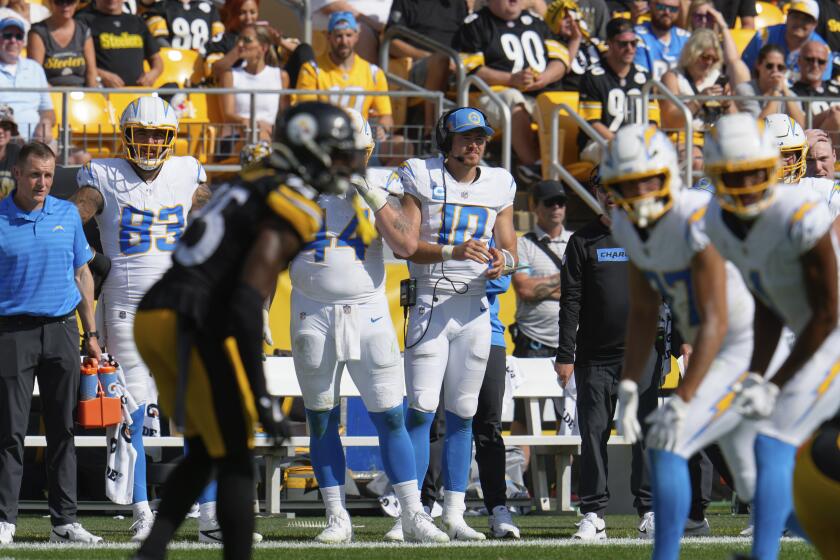Golf Has Scary Week for the Faint of Heart
For the second time in the same week, a professional golfer was released from a hospital Friday, after receiving treatment for a rapid heartbeat, and David Toms is probably going to know LPGA Tour player Meg Mallon a little better very soon.
Mallon, who was released Wednesday from a hospital in Indianapolis, passed along her phone number to PGA Tour officials so that she could speak with Toms, discharged Friday afternoon from UPMC-Presbyterian University Hospital in Pittsburgh.
“I think David had pretty much the exact same thing as I did,” said Mallon, who was resting Friday at her home in Ocean Ridge, Fla. “It’s been an unbelievable couple of days, for me, for David. I feel like I just went through a 12-rounder.”
Toms, 38, an 11-time tournament winner including the 2001 PGA Championship, felt ill during Thursday’s first round of the 84 Lumber Classic in Farmington, Pa.
By Friday afternoon, he was back at the Mystic Rock Course and making plans to play in next week’s Presidents Cup.
Adam Young, executive director of Toms’ foundation, said Toms was in “great” shape.
“It is a non-life-threatening condition that can either be treated with medication or cured with minor surgery,” Young said.
The incidents, however, point out that pro golfers, unlike athletes in other major sports, are on their own when it comes to physical exams. Neither the PGA Tour nor the LPGA Tour mandates them. Professional golfers are regarded as independent contractors and they belong to an association, not a union. Physicals are standard components of collective bargaining agreements between pro sports leagues and their players’ unions.
“There’s no team, just individuals,” said Dave Lancer, director of information for the PGA Tour.
According to Dr. James McPherson, a heart expert at the Centinela Freeman Hospital’s Tommy Lasorda Heart Institute in Inglewood, it is a position that may be flawed.
“The question is whether the PGA Tour should mandate or suggest that players have some kind of checkup,” McPherson said. “Golf doesn’t need to be held to the same standards as, say, football or baseball. But you don’t want Jack Nicklaus to drop dead on the golf course. That’s not good, as far as a public relations issue.”
But Mallon, a two-time U.S. Open winner, said she had complete physicals about every five years and that a normal physical would not have revealed her heart condition. She said she had been having episodes of rapid heartbeat since she was 19.
“They told me they were panic attacks,” she said. “It’s the most common misdiagnosis. They sent me to a sports psychologist and I realized that wasn’t helping me.
“Panic attacks? All the pressure situations I’ve been in as a professional golfer, I’ve never had one, so after what I’ve just been through, I feel pretty lucky. They fixed me.”
Toms’ condition was diagnosed as a cardiac rhythm disturbance that caused a rapid heartbeat, the same condition that sent Mallon to a hospital in Indianapolis for three days. She was stricken minutes after making a putt that clinched the Solheim Cup for the U.S. team Sunday at Crooked Stick Golf Club in Carmel, Ind.
Mallon, 42, was treated at the Heart Center of Indiana, where a catheter was used to distribute heat that destroyed a piece of tissue where the rhythm initiates.
Mallon’s heart beat as many as 290 times a minute during her recent episode.
“They were surprised I could even stand up, with my heart beating that fast,” she said.
Mallon said she would be ready to play in the Office Depot Championship next week at the Trump National Golf Club in Rancho Palos Verdes.
McPherson said Toms’ situation may be somewhat different from Mallon’s.
“News reports that said he had chest pains are a little concerning,” he said.
“But he’s a younger person and even though heart disease can occur in a younger person, it’s generally fixable.”
As a rule, McPherson said, anyone over 40 should have an annual physical, and so should those under 40 who have a family history of heart problems.
He also agreed with Mallon that her condition was difficult to detect, even during a physical.
“Sometimes it’s chronic, other times it comes without any warning,” he said. “It’s not the type of thing you could necessarily pick up on an EKG or heart exam unless it was happening at the time. You could be tipped off to heart disease through a stress test, EKG or a heart exam.”
More to Read
Go beyond the scoreboard
Get the latest on L.A.'s teams in the daily Sports Report newsletter.
You may occasionally receive promotional content from the Los Angeles Times.










